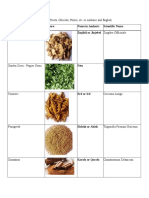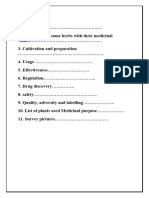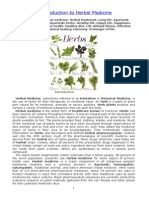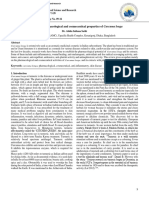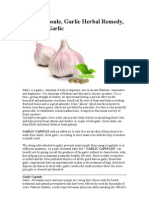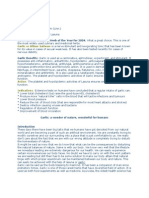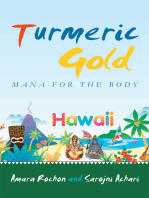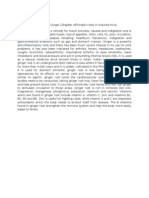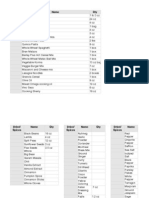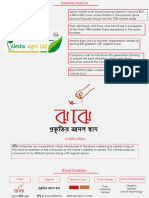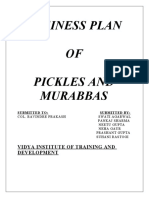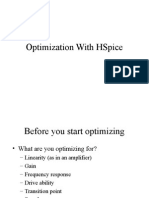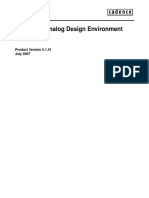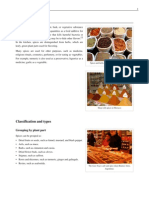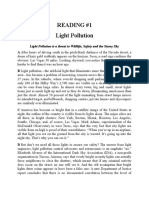Indian Spices and Condaminents As Natural Healer
Indian Spices and Condaminents As Natural Healer
Uploaded by
Rashi SaraogiCopyright:
Available Formats
Indian Spices and Condaminents As Natural Healer
Indian Spices and Condaminents As Natural Healer
Uploaded by
Rashi SaraogiOriginal Title
Copyright
Available Formats
Share this document
Did you find this document useful?
Is this content inappropriate?
Copyright:
Available Formats
Indian Spices and Condaminents As Natural Healer
Indian Spices and Condaminents As Natural Healer
Uploaded by
Rashi SaraogiCopyright:
Available Formats
Indian spices and condiments as natural Healers
The history and culture of Indian spices and condiments is probably as
old as human civilization itself. There are numerous references about
them in Vedas, the Quran and the Bible. The earliest record of Indian
Spices and condiments is in the Rig Veda, around in 6000 BC.
India, due to its Indian spices is famous from its prehistoric times. Even
if it has grown a lot in industrial section in modern times it is still known
as the “Home of spices”. This is because of the best quality spices and
condiments produced in and exported from this country.
The term spices and condiment refers to the natural plant or vegetable
products which or the mixture which are virtually indispensable in
culinary art. Indian spices can be used in various ways such as fresh,
ripe, dried, Whole, broken or fiber. This enhances the taste, flavor,
color, texture and aroma. Many of them possess nutritional and
medicinal property and have a profound effect on human health.
Various researches have also shown that the spices and condiment
possess the property of curing various common ailment Such as:
Anti-Gas Activity: Indian herbs have long been used in ancient,
medicine as carminatives – agents that help expel gas and relieve
flatulence. The main pharmacological secret is considered is
presence of natural oils in the herb plants. These oils relax
smooth muscles, thereby allowing gas to escape. For the
carminative activity we use aniseed, asafetida, bishop’s weed,
caraway seeds, cinnamon, clove, dill, fennel seeds, garlic, ginger
and mint.
Anticoagulant Activity: certain Indian spices and condiments like
chilly pepper, garlic, clove, onion and ginger serve as
anticoagulants. This mainly discourages the small blood
component-platelets, from clumping together or aggregating.
They are non sticky herb plants and hence build less clots that can
clog arteries which can prevent heart attacks
Antidepressant activity: some spices and condiments serve as anti
depressants and help elevate moods by changing brain chemistry.
The Indian spices like cardamom, chilly pepper and garlic
manipulate mood by influencing serotonin, one of the brains
most remarkable neurotransmitters
Painkilling activities: For years people have put hot pepper extract
on their gums to alleviate toothache. Now it is known that
capsaicin in peppers serves as a local anesthetic and painkiller.
Also asafetida, cloves, ginger, garlic, mustard seeds, nutmeg,
onion and poppy seeds are special Indian spices that act as a
painkiller.
Mucus – Clearing activity: It has been known for centuries that
hot, spicy, pungent foods can help clear the lungs and breathing
passages. They do so by thinning mucus and encouraging it move
along. Indian Spices like chilly-pepper, clove, fennel, garlic,
ginger., mustard seeds, onion, tamarind and turmeric thin out and
help move the lung’s secretion so that they do not congest the air
passages and can be coughed out or expelled in a normal way.
Antibacterial Activity: Garlic was the first antibiotic food that was
used against germ and it was discovered by Louis Pasteur in 1858
that garlic and other Indian spices have antibacterial factors in
them. Other Indian spices like clove, cumin seeds, ginger, onion
and turmeric have anti bacterial factors.
Anti-diabetic activity: certain Indian herbs and condiments like
cinnamon, curry leaves, fenugreek seeds, garlic and onion possess
anti diabetic activity. These Indian relish are dill, fenugreek seed,
garlic and onion possess anti diabetic activity. Their use can help
lower blood sugar or stimulate insulin production in treating
diabetes.
Anti inflammatory Activity: Recent medical discoveries have
shown that certain Indian spices and condiments can reduce
inflammation, which is a key process in arthritis and other
rheumatic affliction. They help manipulate the prostaglandins
system to block the process of inflammation. They can also
intervene in various stages to block the complex biochemical
inflammatory process. These Indian herbs and condiments
includes garlic, ginger, onion, tamarind and turmeric.
Anti-viral Activity: Certain spices and condiments fight various
types of viruses, which enter the body through air, water, food,
scratches and wounds of the skin, and thereby help prevent viral
diseases. They are basil, cinnamon, dill, garlic, ginger, onion and
turmeric
Calming and sedative property: Certain spices and condiments
such as aniseed, cumin seeds, dill, nutmeg, and poppy seeds serve
as sedatives and tranquillizers. They work as sedatives by
stimulating the activity and levels of neurotransmitters, such as
serotonin that calms the brain
Anti-diarrheoal Activity: some spices and condiments possess anti
diarrheoal activity. These are dill, fenugreek seeds, garlic, ginger,
mint, nutmeg and turmeric. They help counteract diarrheoa
effectively as they contain tannins and astringent compounds.
These spices fight bacteria in the intestines and thereby exert a
Soothing effect. They help drain water out of the gut and solidify
faeces.
You might also like
- Ethiopian Herbs and SpicesDocument11 pagesEthiopian Herbs and Spicesyosef100% (2)
- Data Buyer 24 Oktober 22Document37 pagesData Buyer 24 Oktober 22tazkiya100% (1)
- Review: Power System Analysis Software ToolsDocument6 pagesReview: Power System Analysis Software ToolsTaoplayer100% (2)
- Advanced Meat ProcessingDocument23 pagesAdvanced Meat ProcessingAl Pavillon100% (1)
- Medicinal Plants and HerbsDocument4 pagesMedicinal Plants and HerbsC.S. Nworu100% (1)
- The Secrets of Spices: Natural Remedies and Their ApplicationsFrom EverandThe Secrets of Spices: Natural Remedies and Their ApplicationsRating: 5 out of 5 stars5/5 (1)
- Indrajit Nandan Ca2 F&B Production.,.Document9 pagesIndrajit Nandan Ca2 F&B Production.,.INDRAJIT NANDANNo ratings yet
- CsherbalplantationDocument66 pagesCsherbalplantationkrish47mkNo ratings yet
- Seminar 12Document70 pagesSeminar 12Ishita MallickNo ratings yet
- 88 Chapter-8-Role of Aromatic PlantsDocument2 pages88 Chapter-8-Role of Aromatic PlantsDavid VermaNo ratings yet
- Tr4 Les C3a9picesDocument12 pagesTr4 Les C3a9picesBinafou TraoreNo ratings yet
- Ayurveda FitoterapiaDocument112 pagesAyurveda FitoterapiaKerol Bomfim100% (2)
- Spices and HerbsDocument7 pagesSpices and HerbsJohn PertierraNo ratings yet
- Frankincese/Gum Olibanum: Uses of FrankincenseDocument3 pagesFrankincese/Gum Olibanum: Uses of FrankincenseMufaddal VhoraNo ratings yet
- Beginner's Guide to Cooking with Spices: Essential Spices and Herbs, #9From EverandBeginner's Guide to Cooking with Spices: Essential Spices and Herbs, #9No ratings yet
- Recent Trends in Indian Traditional Herbs Syzygium: Aromaticum and Its Health BenefitsDocument10 pagesRecent Trends in Indian Traditional Herbs Syzygium: Aromaticum and Its Health BenefitsAbshari R. SudjatmokoNo ratings yet
- Jurnal CengkehDocument10 pagesJurnal CengkehhiiaiiNo ratings yet
- A Review On Pharmacological and Cosmeceutical Properties of Curcuma LongaDocument8 pagesA Review On Pharmacological and Cosmeceutical Properties of Curcuma Longaaprilia ciet cietNo ratings yet
- 1 7 13 124 PDFDocument8 pages1 7 13 124 PDFaprilia ciet cietNo ratings yet
- Medicinal Plants and Their PropertiesDocument7 pagesMedicinal Plants and Their PropertiesRam PrasadNo ratings yet
- Spice BeniftsDocument26 pagesSpice Beniftschandanparsad100% (1)
- Essential Spices and Herbs: Ginger - Health Benefits, and Recipes: Essential Spices and Herbs, #2From EverandEssential Spices and Herbs: Ginger - Health Benefits, and Recipes: Essential Spices and Herbs, #2Rating: 5 out of 5 stars5/5 (1)
- A Spice: Sundara VeerrajuDocument53 pagesA Spice: Sundara VeerrajuSundara Veerraju100% (2)
- Part B Herbs and Their Healing Practices NotesDocument1 pagePart B Herbs and Their Healing Practices NotesDivyam KashyapNo ratings yet
- Cayenne Pepper Cures The Fire of Life Ancient Cures, Healing RemediesDocument61 pagesCayenne Pepper Cures The Fire of Life Ancient Cures, Healing Remediesvalentinabday03No ratings yet
- GarlicDocument7 pagesGarlicMaharshi ShrimaliNo ratings yet
- Marketing of Indian Spices As A Challenge in India: Sajith Mohan, Sheena. S.Rajan, Unnikrishnan.GDocument6 pagesMarketing of Indian Spices As A Challenge in India: Sajith Mohan, Sheena. S.Rajan, Unnikrishnan.GVishwas JNo ratings yet
- The power of Ayurvedic spices: Health Secrets from Acient IndiaFrom EverandThe power of Ayurvedic spices: Health Secrets from Acient IndiaNo ratings yet
- Pharmacognosy NotesDocument2 pagesPharmacognosy NotesRishabhNo ratings yet
- Cooking With Herbs and Spices: "Variety Is The Spice of Life"Document16 pagesCooking With Herbs and Spices: "Variety Is The Spice of Life"Lila KarapostoliNo ratings yet
- Native American’s Herbalist’s Guide: The Ultimate Herbal Medicine Encyclopedia. Create Your Apothecary Table and Discover Ancient Remedies to Improve Your Overall Well-BeingFrom EverandNative American’s Herbalist’s Guide: The Ultimate Herbal Medicine Encyclopedia. Create Your Apothecary Table and Discover Ancient Remedies to Improve Your Overall Well-BeingNo ratings yet
- Fch14 04 Leader Guide Spicesof IndiaDocument14 pagesFch14 04 Leader Guide Spicesof IndiaHem Chandra PantNo ratings yet
- SpicesDocument8 pagesSpiceshopesosomaNo ratings yet
- Herbs For Eliminating ToxinsDocument23 pagesHerbs For Eliminating ToxinsPeter jörgNo ratings yet
- ELIXIR Natures Healing HerbsDocument312 pagesELIXIR Natures Healing HerbsNibodha Educational Concepts100% (3)
- 40 Herbs KindleDocument81 pages40 Herbs KindlePersona GrataNo ratings yet
- Production of Herbs in Asia: An Overview: Narong ChomchalowDocument16 pagesProduction of Herbs in Asia: An Overview: Narong ChomchalowJimmy DanielNo ratings yet
- 6-3-36-573Document7 pages6-3-36-573Minugu c chiduNo ratings yet
- Spicy Bone Broths: Essential Spices and Herbs, #12From EverandSpicy Bone Broths: Essential Spices and Herbs, #12Rating: 5 out of 5 stars5/5 (1)
- Medicinal Uses of Spices Used in Our Traditional Culture: World WideDocument8 pagesMedicinal Uses of Spices Used in Our Traditional Culture: World WideYitbarek AbrhamNo ratings yet
- Sex TipsDocument115 pagesSex TipsJayadev MotamarriNo ratings yet
- Home Remedies For A Stuffy Nose These All-Natural Cures Should Provide Relief From The Pressure and Pain of Stuffy NoseDocument26 pagesHome Remedies For A Stuffy Nose These All-Natural Cures Should Provide Relief From The Pressure and Pain of Stuffy Noseendalkachew gudetaNo ratings yet
- Indian Spices and Their Medicinal Value: Garnish Kitchen IndiaDocument3 pagesIndian Spices and Their Medicinal Value: Garnish Kitchen IndiaRicha SharmaNo ratings yet
- CHN BawangDocument3 pagesCHN BawangNicole MapiliNo ratings yet
- Garlic (Allium Sativum) Passion Flower (Passiflora Incarnata) Cat's Claw (Uncaria Tomentosa)Document2 pagesGarlic (Allium Sativum) Passion Flower (Passiflora Incarnata) Cat's Claw (Uncaria Tomentosa)Kaykay MadrigalNo ratings yet
- Formulation and Evaluation of Polyherbal Cough GutikaDocument6 pagesFormulation and Evaluation of Polyherbal Cough GutikaInternational Journal of Innovative Science and Research TechnologyNo ratings yet
- Garlic CapsuleDocument4 pagesGarlic CapsulechongtroiNo ratings yet
- The Term "Medicinal Plant" Includes Various Types of Pants Used in HerbalismDocument6 pagesThe Term "Medicinal Plant" Includes Various Types of Pants Used in Herbalismjayashree dhanapalNo ratings yet
- 16 Medicinal Plants to Keep in Your House Bilingual Edition English Germany Standar VersionFrom Everand16 Medicinal Plants to Keep in Your House Bilingual Edition English Germany Standar VersionNo ratings yet
- Medicinal PlantsDocument6 pagesMedicinal PlantsHanz DavidNo ratings yet
- Pumpkin Nutrition FactsDocument196 pagesPumpkin Nutrition FactsPriya Bisht100% (1)
- Garlic Benefits AyruvedicDocument7 pagesGarlic Benefits AyruvedicMushtaq M.ChinoyNo ratings yet
- National College of Arts Research Proposal: Spices of India: Turmeric - A Cure To MaladyDocument3 pagesNational College of Arts Research Proposal: Spices of India: Turmeric - A Cure To MaladyZeb ArshadNo ratings yet
- Health TipsDocument102 pagesHealth Tipsgurkirt100% (1)
- 30 Most Popular Herbs For Natural MedicineDocument3 pages30 Most Popular Herbs For Natural MedicineAshish RajeNo ratings yet
- Concept PaperDocument2 pagesConcept PaperAngel CoNo ratings yet
- Stars and Destiny: Medical Astrology and Healing Power of HerbsFrom EverandStars and Destiny: Medical Astrology and Healing Power of HerbsNo ratings yet
- Herbs and Their Therapeutic ValueDocument11 pagesHerbs and Their Therapeutic ValueAnkur GautamNo ratings yet
- Spices Are Used For Taste and CureDocument3 pagesSpices Are Used For Taste and Cureradha235No ratings yet
- Herbal Medicines: Medicinal Teas Medicinal Supplements Medicinal Oil ExtractsDocument20 pagesHerbal Medicines: Medicinal Teas Medicinal Supplements Medicinal Oil ExtractsModiGopi100% (1)
- PantryDocument6 pagesPantrySusie Luna GreenNo ratings yet
- Brand GuidelinesDocument6 pagesBrand Guidelinessakib sadmanNo ratings yet
- Production & Export of Spices in Sri LankaDocument13 pagesProduction & Export of Spices in Sri Lankahasithrock75% (4)
- Tea RecipesDocument11 pagesTea RecipesGeorgios MandelasNo ratings yet
- A Collection of Manual Cooking Cheatsheets For Malaysian IndianDocument41 pagesA Collection of Manual Cooking Cheatsheets For Malaysian IndianpritheckNo ratings yet
- The Indian Cuisine: An Exploration: Gagandeep SinghDocument9 pagesThe Indian Cuisine: An Exploration: Gagandeep SinghLakshit ManraoNo ratings yet
- MATLAB/Simulink-Based Transient Stability Analysis of A Multimachine Power SystemDocument18 pagesMATLAB/Simulink-Based Transient Stability Analysis of A Multimachine Power SystemÄy MênNo ratings yet
- Spices IndustryDocument9 pagesSpices IndustrySanjanaNo ratings yet
- Continuous System Modeling / Francois E. Cellier: February 1991Document10 pagesContinuous System Modeling / Francois E. Cellier: February 1991Tushar RahmanNo ratings yet
- Business Plan OF Pickles and MurabbasDocument10 pagesBusiness Plan OF Pickles and Murabbasswati_agarwal67100% (1)
- Term Paper - HARMONIC BALANCE SIMULATORDocument7 pagesTerm Paper - HARMONIC BALANCE SIMULATORakhilaNo ratings yet
- IEEE Transactions On Power Electronics Volume 6 Issue 2 1991 (Doi 10.1109/63.76804) Lauritzen, P.O. Ma, C.L. - A Simple Diode Model With Reverse RecoveryDocument4 pagesIEEE Transactions On Power Electronics Volume 6 Issue 2 1991 (Doi 10.1109/63.76804) Lauritzen, P.O. Ma, C.L. - A Simple Diode Model With Reverse Recoveryaaaaa kkkkNo ratings yet
- Hspice OptimizationDocument8 pagesHspice OptimizationAnand ThibbaiahNo ratings yet
- Lab Manual: 1.NAME: Sujal PranamiDocument28 pagesLab Manual: 1.NAME: Sujal PranamiSujal PranamiNo ratings yet
- Bhakta Bandhav Calendar 2022 2023Document36 pagesBhakta Bandhav Calendar 2022 2023hkkNo ratings yet
- Introduction To MasalaDocument5 pagesIntroduction To Masalaanand_gsoft36030% (3)
- Marketing Challenger of The Cardamom ProducersDocument23 pagesMarketing Challenger of The Cardamom ProducersAprilia FajriatiNo ratings yet
- Virtuoso® Analog Design Environment User Guide: Product Version 5.1.41 July 2007Document6 pagesVirtuoso® Analog Design Environment User Guide: Product Version 5.1.41 July 2007我是企鵝No ratings yet
- SpicesDocument7 pagesSpicesKrishna ChaitanyaNo ratings yet
- UhDocument3 pagesUhineNo ratings yet
- 9 Best Herbs - Dr. MercolaDocument6 pages9 Best Herbs - Dr. MercolaAirene Abear PascualNo ratings yet
- The Untouchables and The Pax Britannica Dr. B.R.ambedkarDocument61 pagesThe Untouchables and The Pax Britannica Dr. B.R.ambedkarVeeramani ManiNo ratings yet
- Make It Hot, Hot, Hot With Triple Chili Crisp - Recipe - ChefStepsDocument4 pagesMake It Hot, Hot, Hot With Triple Chili Crisp - Recipe - ChefStepshussein ghandourNo ratings yet
- SC AC Simulation PDFDocument5 pagesSC AC Simulation PDFuam22No ratings yet
- Reading 1Document13 pagesReading 1Miruna Catalina Ioana100% (1)
- DSPFDocument5 pagesDSPFChristiensen ArandillaNo ratings yet
